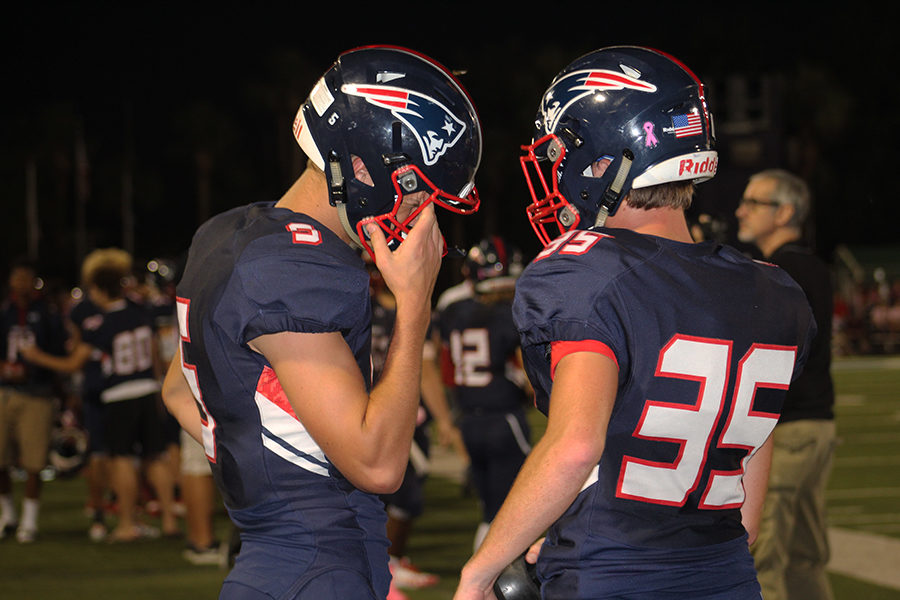Football: High Risk for Head Injuries
Photo provided by: Bridget Froemming
Senior Will Pikalow and junior Jett Boss discuss their last moves at the Tom Storey Field as the end of the game approaches on Friday, Oct. 20. Lake Brantley won with a score of 49, beating Oviedo by 21 points.
January 17, 2018
According to CBS News, football players have head-to-head collisions 30-50 times a game, with some of those hits equaling a car crash in severity. That is not healthy for the human body. When the viewer adds in the seemingly nonstop shoves, pinches, spears, kicks, and slams, football rapidly goes from a shiny event people see every Sunday afternoon, to a gladiator-esque bloodbath. Sophomore Brandon Boyer knows these truths all too well.
Boyer plays on the junior varsity football team, and his position is defensive tackle. Fresh off of a successful 6-2 season, the team has been in the offseason for about a month. However, the lasting effects of the grueling season can be interminable. Concussions, or traumatic brain injuries, are the subject of much debate between doctors and players. Concussions are closely linked to Chronic Traumatic Encephalopathy, a degenerative brain disease that can cause dementia, aggression, and mood swings. This topic hits close to home for Boyer.
“I’d say that head related injuries are obviously very common and it’s very unlikely that a player doesn’t get one once every week,” Boyer said. “We all understand the risks that are associated with concussions, but I think we all have just grown used to it.”
With so much risk in the sport, many parents have been inclined to pull their child from the game completely. However, athletic trainer Michael Holmes says that the problem is not the amount of collisions, but rather the form.
“The most efficient way to reduce the number of concussions is by learning how to properly tackle,” Holmes said. “Too many young athletes, even some professionals still attempt to tackle by using their head. This is why the NFL has so many rules regarding head to head contact.”
Another possible problem could be the amount of preparation players have. Doing extra workouts and training can make a gargantuan difference when the lights are shining on Friday night.
“During the off season it is very important for players to participate in other activities and workouts,” Holmes said. “Student athletes who play one sport are much more likely to be injured because their body becomes accustomed to a very one dimensional activity and does not build muscle in parts of their body that they may not use frequently in their specific sport.”
Besides concussions, football is still an incredibly violent sport. What is considered major injuries to the common person translates into mere scratches for a football player. These smaller injuries are treated on the field, and are evaluated by the staff to decide whether the player can keep playing.
“Injuries are pretty frequent in regards to football,” Holmes said. “About every game or practice there is at least some type of minor injury. Severe injuries are probably around 10 a season. They are treated on the field based on the nature of the injury. Usually a very quick evaluation to determine the severity and if they can get off the field. After that we will evaluate it further to determine exactly what the injury is and how bad it is.”
Despite all of the risks, football still remains the pinnacle of sports and entertainment in America. This is not an accident. The entertainment value for the viewer is always there, and players want to keep playing.
“Everyone on the team knows how violent of a sport it is, but everyone still shows up,” Boyer said. “That’s because we all enjoy it, and have a good time. If anyone doesn’t want to play because it’s too violent, they can quit. But the teams are still full, which should show the dedication we all have.”






